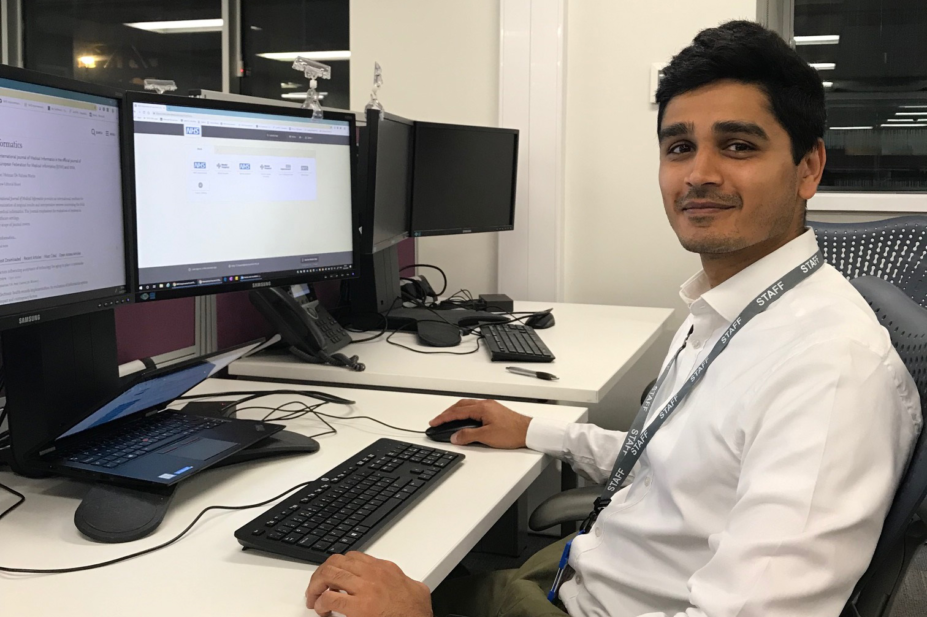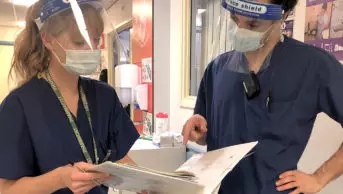
Courtesy of Jaidev Mehta
I work for NHS England and NHS Improvement as a pharmacy business intelligence manager. This involves monitoring and reviewing large amounts of medicines utilisation data at trust and national level to help providers improve how they use, prescribe and administer medicines — reducing unwarranted clinical and operational variation.
09:00 — start
On the way to work I check our team WhatsApp group which gives me the highlights of who is where today and any travel issues. When I get to work, I start my day with a coffee and check my emails, responding to anything urgent.
Today, I have a query from an NHS trust about the top ten high-cost medicines list, and other queries relating to targets at trust level.
I review important data around how trusts use, prescribe and administer medicines, and associated costs, via a system called the Model Hospital — a digital information service designed to help NHS providers improve their productivity and efficiency. All pharmacy-related queries on the system are routed to me. I review each of these and draft a response for the Model Hospital team to officially respond to trusts on behalf of the pharmacy and medicines optimisation team. I work closely with them to facilitate implementation of Lord Carter’s 2016 recommendations, which are based around hospital productivity and spending. This involves using medicines use data to identify and drive efficiencies in secondary care pharmacy by using benchmarking metrics.
Occasionally, trusts will email me directly with queries, which I do respond to directly but all responses are forwarded to the Model Hospital team so that a database of queries and responses can be maintained to aid consistency. It also helps capture meaningful feedback and improve the Model Hospital service.
10:00
I have a conference call with the Model Hospital team to discuss the methodology for calculating the top ten medicines’ annual and monthly financial targets for financial year 2019/2020. The goal is to benchmark medicines use and track unwarranted variation in the top ten high-cost medicines. The current top ten medicines on Model Hospital are: adalimumab, etanercept, infliximab, rituximab, etanercept, trastuzumab (intravenous formulation), imatinib, caspofungin, valganciclovir, voriconazole and linezolid.
Determining the top ten targets allow trusts to identify the value of potential savings through best practice and switch to less costly versions, and recognises increased access to the medicine within the savings calculation. This is an intense discussion as getting the methodology right is of the utmost importance to trusts and allows benchmarking of best practice.
After the conference call, I join my pharmacist colleague who is leading on a review to discuss the data required to identify the use of premixed products and unlicensed specials. My input for this discussion is around the ‘art of the possible’ — this means providing the available medicines utilisation data and interpreting it to gain an understanding of how these medicines are used across the NHS in England.
11:00
Before lunch, I have a meeting onsite with a project management team for a rheumatology Getting it Right First Time (GIRFT) workstream. The GIRFT programme is designed to improve the quality of care within the NHS by reducing unwarranted clinical and operational variations, and is led by frontline clinicians who are experts in the areas they are reviewing.
Today is a follow-up meeting to review how medicines are being used by the rheumatology speciality in secondary care. Using this data, we create draft metrics for the rheumatology workstream. These draft metrics address potential clinical variations; best practice around uptake of newly introduced biosimilar medicines (e.g. adalimumab) in accordance with the commissioning framework in England; and medicines utilisation for the rheumatology speciality.
The approved metrics will be piloted within a few trusts once the methodology and presentation are finalised. It will be an iterative process of creating and refining them over the next couple of weeks prior to pilot site visits by rheumatology GIRFT clinicians.
13:00
I sit down and brainstorm the creation of a ‘procure for safety’ metric for magnesium sulphate intravenous formulations, used to reduce the risk of cerebral palsy in preterm babies (<30 weeks’ gestation). ’Procure for safety’ refers to buying pharmaceuticals that enable safe handling and administration. For example, magnesium sulphate 10% pre-filled syringes would be ready to administer while 50% ampoules would need diluting to 20%. Although pre-filled syringes are more expensive in the short term, their potential to improve the quality of outcome for mothers and their babies is significant.
This is an ongoing piece of work that I dedicate some of my time towards. There are a lot of steps involved, including:
- Looking into medicines utilisation data;
- Working out whether data is applicable to all trusts or just some;
- Evaluating whether data allows calculation/creation of a meaningful metric that allows benchmarking of good practice;
- Understanding the basis for creating such metrics;
- How that metric will impact service provision and frontline staff.
I continue to learn about medicines utilisation patterns and the impact of prescribing in primary and secondary care on medicines budgets
14:00
Within my role, I continue to learn about medicines utilisation patterns and the impact of prescribing in primary and secondary care on medicines budgets. Today, I review utilisation patterns for second-line medicines prescribed for type 2 diabetes mellitus.
My primary data source for secondary care medicines utilisation is Define software by Rx-Info, and for primary care it’s ePACT2 which is an online application from the NHS Business Service Authority – the health authority which provides a range of critical central services to NHS organisations, NHS contractors, patients and the public. Other sources of data and metrics for primary care which are incredibly useful to commissioners include OpenPrescribing, the evidence based medicine data lab at the University of Oxford and PrescQIPP, a community interest company.
16:00
I review trust level metrics on Model Hospital. These enable the comparison of overall pharmacy efficiency including prescribing, operational delivery, use of digital tools and indicators of leadership and people management. For example, the ‘Use of inhalation anaesthetics — % Sevoflurane’ metric is updated monthly — this shows the percentage sevoflurane compared to the total percentage sevoflurane, isoflurane and desflurane expressed as a percentage value. One of the rationales is that the newer inhalation anaesthetics have a faster recovery rate than isoflurane and can support faster turnaround of day case operations; improving operational productivity.
17:00 — finish
Before wrapping up for the day, I sign off the sevoflurane metrics via an email to Model Hospital analysts. The metrics will be made ‘live’ on Model Hospital the next working day and this will be communicated to the trusts via official communication channels.
I usually unwind by taking stock of daily activities and having a quick chat with my colleagues over any important meetings/issues to plan next steps. This helps me plan for the next day and keep track of workload throughout the week.
Information for pharmacists interested in a similar role
- My role comes under NHS Agenda for Change 8b and is essentially an analyst role with a specialty in pharmacy;
- Previous experience working with medicines utilisation data is beneficial, yet not essential but you do need to have an understanding of data driven care;
- It is useful to understand the impact of implementing digital systems on operational aspects of pharmacy and medicines supply, end user impact and interoperability with other systems;
- Take active interest in networking with like-minded colleagues and make efforts to keep up-to-date on changes happening nationally that may impact medicines utilisation, digitisation and digital standards;
- Ask around for opportunities to increase experience and exposure if you see something interesting. For example, undertaking projects, shadowing, placements or secondments can help you understand and appreciate the workings of the NHS;
- Identify your learning requirements and ask management for support — I got promoted to project manager because I asked to be put on a PRINCE2 practitioner course.
You may also be interested in

‘Pharmacy plays a vital role in maintaining patient flow and efficiency of discharges’ – a day in the life of an orthopaedic pharmacist

‘Nothing compares to it’ — a day in the life of a child and adolescent mental health pharmacist
